

|
Back to |
| The Front Page |
| News & Features |

|
The Ponte Vedra Croquet Club could change the culture of the sport |
|
by Bob Alman most photos by Fred Hunt; others by Steve Johnston layout by Reuben Edwards Posted March 24, 2015
|
This has to be a first-person story, because John Curington and I worked together on a daily basis for more than a year after Chuck Steuber hired me in 2000 to organize and manage the new 10-acre National Croquet Center in West Palm Beach. John and his Jacksonville crew had already been working there for many months, building twelve of the best courts ever constructed in America. I had been organizing the NCC from San Francisco by phone with Steuber and pro Archie Peck, and we already had about a hundred members, many of whom had donated an extra thousand dollars to the ground-breaking national USCA headquarters project along with their first-year dues. On December 7, 2000, a huge crowd came to play on the newly-grown courts at our opening party, drink a toast to Chuck, and gorge on barbecue with John officiating at the grill. The maintenance shed, we found, was a fully sufficient clubhouse for the next year and half--until the "real" clubhouse was completed.
So Curington already knew that a metal structure built for maintenance could be arranged, organized and managed to work perfectly well as a clubhouse. The Players Pavilion at Ponte Vedra is just such a structure, and much better located--centrally, between the two groupings of courts--than the Maintenance Shed of the National Croquet. So that metal shed has become the Ponte Vedra clubhouse.
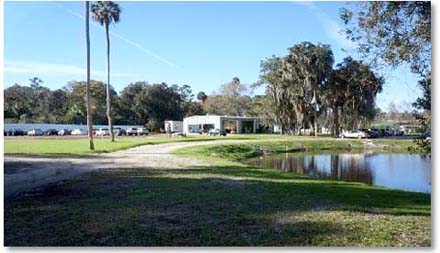
|
| This is what you see when you enter the gates from Mosquito Control Road (shortly to be renamed Croquet Drive): The cars on the left are parked on what will be the final four courts, while the cars on the right are in the designated and permanent parking area. When the facility is completed, the foreground will accommodate overflow parking. |
John's responsibilities at Ponte Vedra encompass much more than gifted and gracious host and barbecue chef extraordinaire. He bought the property, planned it, financed it, built the lawns and re-purposed the buildings, and intends to manage the complex to break-even within three years! In order to afford it, he's given himself a 24-hours-a-day job more challenging than even he at first imagined. He won't tell you this when he greets you at the already impressive site to inspect the facility and play on his courts--because he's a gentleman of the old school. He's much too polite to say anything a stranger might construe as complaining.
But I can report that with my incessant grilling, I succeeded in eliciting by email the kind of gritty, quotable language every writer dreams of putting into the heart of their story: Here's an email snapshot of the pressures John has brought upon himself in creating, managing, and being wholly responsible for this amazing complex practically in his back yard.
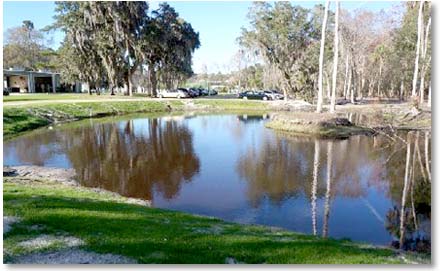
|
| Curington plans to create a quiet retreat on the area beyond the pond, cleared now for plantings we'll show in all their flowering glory in our October story on the Ponte Vedra Croquet Club's Grand Opening day. |
Answering repeated inquiries, John's email said, "Bob, two break-ins, a busted irrigation pump (Monday), County issues on the sewer and water lines, lessons on Saturday and Sunday, weather delays--what have I got myself into? Of course most problems go away with cash but that is the one thing that makes this project so challenging. I am trying to build a million dollar facility for half that.
"I'm sorry if I seem unresponsive....but imagine getting 20 to 50 telephone calls a day and not knowing when you pick up the phone if it's a potential new member (whom you can't blow off), a County official asking for five more sets of plans, the local paper wanting some updates, or your grounds keeper saying the mower broke down (generating five more outgoing calls)."
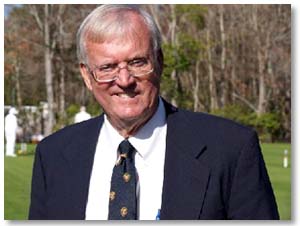
|
| Curington is justly proud of his never-been-done-before-anywhere project near the Atlantic coast in Jacksonville, Florida. Although the facility is open already and collecting members (whose annual dues actually carry them all the way through 2016), many vexing challenges and decisions are still to be made before the Grand Opening in October 2015. |
Nailing down the point, John's email continues: "And by the way I don't get these calls while I'm sitting comfortably behind a desk. I get them while I'm wiping grease from the tractor, cutting tree limbs, directing workers or volunteers, or when I'm on the phone with someone else. And then the emails keep coming all day long."
That's gritty copy. But it doesn't by any means include everything Curington has to manage. He actually loves the "East Coast" tradition of croquet in America, played by ladies and gentleman who always behave like ladies and gentleman, in an environment designed to be enjoyed appropriately by croquet-playing ladies and gentleman. In the invitation to the Ponte Vedra "soft opening" in late January, he made this explicit. After a description of all the work still to be done, he commented, "But besides the physical improvements will come a dynamic recreational/social club: a breeding ground for lasting friendships, serious fun and national champions."
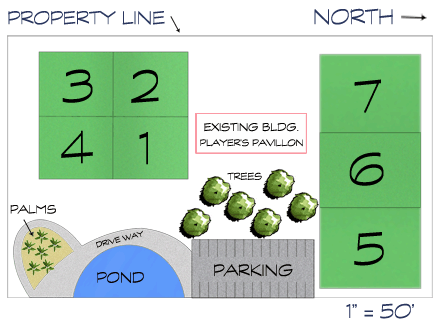
|
| The site plan for the 3/12 acre club shows how well all the basic elements are organized to work together harmoniously. The Players Pavilion in the center looks smaller than it is; you can see here that it's actually longer than a full-sized court. All of these elements and more are already in place, including a picnic table beneath the trees. Coming next is quite probably a pre-fab structure between the Pavilion and the north property line, living quarters for the one full-time paid employee who will double for maintenance and security. |
The opening in early 2015 was "soft"
It was "soft" because with only three of the seven courts ready for play, much of the facility was yet to be constructed. Nevertheless, more than 50 people (40 were invited!!) showed up on a bright, warm January day designed to advertise Jacksonville as a place with a year-round climate it almost lives up to.
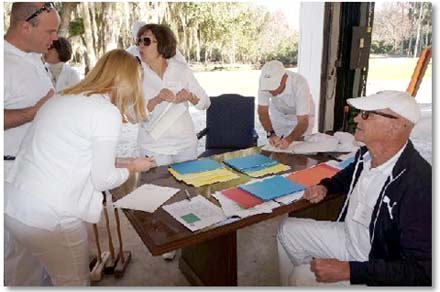
|
| Curington made sure all the guests on Opening Day got full information on membership fees and categories, while Bob Alman (sitting, in foreground) collected their names and email addresses. Every person and couple who requested it now receive a weekly e-letter formatted and composed by Fred Hunt, who took these pictures. Fred's weekly announces the Saturday and Sunday playing schedules and special events in the Pavilion, profiles new members, and reports news of the progress on the facility. |
Actually, Jacksonville is in a "transitional" zone; one can't know whether the bent grass to be planted in May and June will wear well through the next winter season (the "high season" in Jacksonville) or if an overseeding of rye might be necessary. A factor that mitigates towards having one bent-grass that lasts year-round is the nearness of the PVCC to the Atlantic Ocean, barely a mile away, moderating the climate year round, producing warmer winters than inland, and cooler summers.
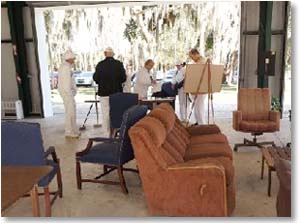
|
| Tall oaks festooned with Spanish moss separate the Players Pavilion from the parking lot in the background. |
In addition to providing a delightful retreat for older people with mallets, he needs to figure out how to make the Ponte Vedra Croquet Club an activity focus for younger, working-age people looking for business as well as social networking--meeting and interacting with their peers in a social environment that includes food, drink, and socializing in the Pavilion along with One-shot Croquet on the adjacent lawn.
One-shot Croquet? That's the term John uses with all the first-timers he introduces to the sport, and it actually works to quickly communicate the critical distinction between Golf Croquet and that other game, which he calls Continuation Croquet. The clarity and economy of it are compelling--so much so that even the local croquet veterans are calling it that, embracing at the same time their newfound ability to describe both the more complex games (AC and American Rules) as Continuation Croquet. It makes perfect sense, but will it fly? Of course it will! (Today, Ponte Vedra, tomorrow the world!)
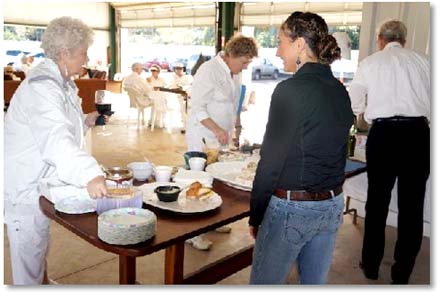
|
| The northeast corner of the Pavilion is organized for food and beverage service, with refrigeration, microwave, storage cabinets, and everything needed for parties and entertainment. |
In addition to shelter and relaxation for the club members during the day, many of them snowbirds who fly north for the summer, the Players Pavilion in the center of the complex can double for at least one night a week as a social hangout for the after-work crowd in an environment that may properly be labeled Postmodern Industrial Chic.
Curington's marketing effort--to event planners and corporate groups especially--will include newspapers, television, radio, internet, and even--get this--Groupons! He will try to limit his involvement on the courts, after the facility is open fulltime, to hosting and instruction, and to managing corporate and other paid group events. By then, the corps of willing and capable volunteers will have swelled to cover the jobs of what otherwise might be paid employees.
How it all came together in North Florida
A normal person might either soar in this condition, or crash, depending on his or her disposition. Curington probably touches both extremes on a regular basis--maybe even weekly, if not daily. But does a "normal" person get serious about the organized, "serious" sport of croquet: Does a normal person invest his personal fortune along with a lifetime of experience and intuition into the kind of enterprise that has never, in the history of the sport, been tried, much less succeeded? Probably not. That would require a most unusual commitment from an extraordinary individual.
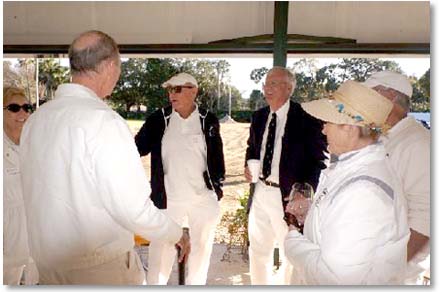
|
| The Pavilion overlooks on the south end the final four courts to be built, on top of a sewer line that has to be installed first. John Curington in the blazer politely laughs at a Bob Alman remark. |
The important element here is the commitment. There's no turning back now. The thing is done. The bills are coming in, and they're being paid, but soon the Ponte Vedra Croquet Club will have to be organized to pay for itself. By the time of the GRAND OPENING this fall and the beginning of the first full "high season" of croquet at the Ponte Vedra Croquet Club, we'll be able to make a more complete assessment of the club's practical prospects, with some numbers attached.
I can't help thinking that much of Curington's motivation must come from his long history with croquet officialdom in many roles, but always tied to other individuals or organizations or committees and to some degree bound by their collective judgements instead of his own.
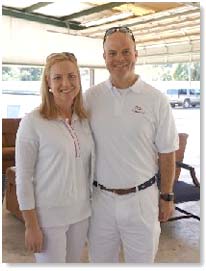
|
| These players are among many couples who already belong to one- and two-lawn clubs in and near Jacksonville who will come to Ponte Vedra for competitive play on the courts and socializing in the airy Players Pavilion. The Ponte Vedra Club will be for North Florida what the National Croquet Center has become for South Florida--the place all the players come for big social and playing events. |
That proposal for a croquet complex co-financed by the Croquet Foundation of America and the city of West Palm Beach (whose sports commission motto is "the best of everything") was carefully crafted, calling for four courts dedicated to croquet with two adjacent lawn bowling courts that could be utilized for major events, giving the USCA a national headquarters potential with six on-site courts and many other courts within easy distance, sufficient for major national and international events.
John's famous failure with this initiative might have been the critical factor in Chuck Steuber's decision just a few years later to create, as president of the Croquet Foundation of America, a suitable headquarters for American croquet in West Palm Beach. It was certainly a factor in Steuber's later choosing Curington as the builder of the courts at the Center, as soon as the land was cleared.
A longtime career in real estate development
Curington, born and bred in Jacksonville, grew up to become something of an expert in buying, improving and selling properties in up-and-coming neighborhoods. He owned and managed several such properties in the San Marco district, once run-down and now a popular spot for dining, nightlife, and entertainment. He owned and developed there the two-story Buddha Bar, and just down the street, he and his partner rescued from the wrecking ball the last single-screen movie house in the county, an Art Deco gem they revitalized by replacing every third seat with a table-top to allow the serving of beer, wine, and food to movie-goers.
In the course of doing all this work, Curington has often interacted with the county boards essential in providing the inspections and permits needed to open and operate such properties.
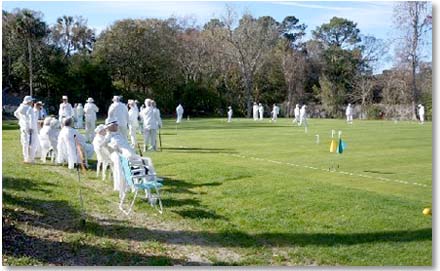
|
| On winter rye grass, the games on the Championship Courts on the north side of the club were soon under way on Opening Day. Since that opening, some of the trees have been trimmed to reduce shading on the lawn as well as other bio-debris falling from them. |
He describes the history of his search for a croquet facility in the folders I handed out to players and guests on the Opening Day in January: "The Ponte Vedra Croquet Club has been a long time coming--over 20 years. The first and most challenging task was to find a good location, but the problem was that Ponte Vedra was almost 100% built out. Repeated attempts at a public/private partnership with the county failed for various reasons. Private clubs, although relatively numerous, did not see the need or interest.
"Ultimately this meant a private dedicated facility needed to be created to satisfy and test croquet demands. The city and county had no public parkland available, except for the library, which a competing group turned it into a nature park."
Other considerations were paramount: "I needed at least several acres for a croquet facility, and I wanted it to be near the coast, near where I live," John told me.
"Ten years ago the Anastasia Mosquito Control District announced a possible location. It was still in use, but soon to close. Initial inquiries revealed that environmental issues would be a major concern. But after five years and a clean bill of health provided by the EPA the site became available. The mosquito district then advertised through public notices for potential users. Ultimately in August 2013 we leased the property and the private croquet club was on its way."
One of the main requirements of a suitable property, for John, was a location close to his own long-time residence, overlooking a well-known golf course in Ponte Vedra, barely a five-minute drive from the Ponte Vedra Croquet Club, three and half acres separating a large public school on Highway One from a middle-class residential neighborhood.
Weighing countless compromises in the balance
With his long experience in building, rebuilding and managing real estate, John is prepared to make difficult decisions affecting diverse interrelated factors bearing not just on construction, but on long-term management and durability. "I'm constantly asking myself," he said, "what degree of perfection am I trying to achieve?"
For example, "To get 12 or 14 on the Stimp Meter that measures the ideal speed of a lawn, what am I prepared to do? And will I be able and willing to afford to maintain the grass at that level?" His court-building experience at the NCC has been augmented by rebuilding the court in nearby Cypress Village in 2005 and two new courts at the Fleet Landing Yacht Club in Atlantic Beach.
The same sorts of questions have been applied to just about to everything at the Ponte Vedra club, and John has already made most of the critical decisions in favor of an agreeable balance between aesthetics and cost. I can guarantee you, for example, that there will be many flowering plants in October at the Grand Opening. And that the decor in the Players Pavilion will have been brilliantly managed by the club volunteers. All traces of the Salvation Army furnishing will have vanished by then; instead, you will be able to luxuriate in a total environment of Postmodern Industrial Chic!
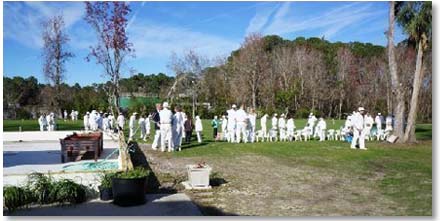
|
| By October, the trees on and around the Ponte Vedra CC will be verdant in their season and augmented with many other flowering plants, including azaleas. This view looks north from the Players Pavilion. |
One practical and manageable compromise has been the placement of irrigation heads on the lawns. "There are good arguments for putting the sprinkler head in the middle of the court instead of on the periphery," John explains, "and when you understand the reasons, it becomes a manageable alternative. You can make it a non-factor, and even a benefit, given the wider choices it gives you in shifting the courts for wear, and having a multitude of alternatives in configuring courts of different sizes for special events."
Curington's long conversation with himself included the question, "How many courts do you need to have a club large enough be self-sustaining--both socially and financially--and that can be efficiently maintained and managed?" All those factors synched into seven courts with a central clubhouse dividing two groupings of courts, with tall trees in the middle permanently decorated with Spanish Moss.
"If you don't have an unlimited budget, costs were and are a huge consideration at every juncture of decision. The type of irrigation and draining system, the types of grasses, the landscape issues of decorative fencing and gazebos, the water features, what to spend on the existing buildings...." John trails off, and I imagine he was talking about the "unlimited budget" we at one time thought we had at the National Croquet Center.
In building and financing this remarkable venue for the sport, John Curington is playing a game even more exciting than top-level croquet--with high stakes and total commitment. He intends to win, and it's hard not to root for him. What player wouldn't want to witness such a game at close quarters, watching how it plays out at every stage?
Many factors are yet to come into play before the Grand Opening of the Ponte Vedra Croquet Club in October 2015. It's one more critical juncture in the development of this first-ever venture, and I, for one, intend to be there to see it first-hand. If you're not there yourself, you can read about it here, and see our pictures of the refurbished Players Pavilion and the crowds in white, with ongoing play on all seven courts......
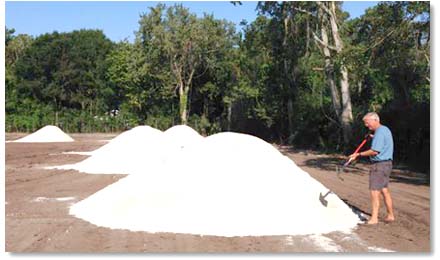
|
| John Curington is involved in every aspect of the Ponte Vedra Croquet Club, including inspecting the first loads of fine-grain sand arriving in October 2014. The late Steve Johnston chronicled in these snapshots the early building phase. He and his wife Pam became the first donors as Lifetime members of the club. |
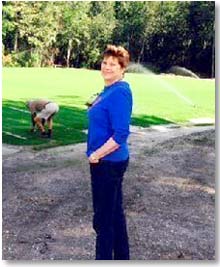
|

|
| Pam Johnston is in the foreground, while Curington in the background fiddles with an irrigation head. | A third Johnston snap shows Curington in December mowing and spraying the winter rye for fungus in the same operation. |